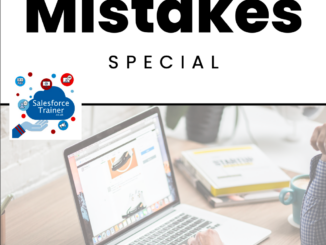Implementing Salesforce can significantly transform sales processes and drive organizational success. However, successful adoption of Salesforce requires overcoming certain challenges and implementing best practices to ensure user engagement, efficient implementation, and maximum return on investment. In this blog, we will go into the common adoption challenges faced by organizations and explore best practices to overcome these challenges. By understanding and addressing these challenges proactively, businesses can foster a culture of Salesforce adoption, drive user engagement, and achieve successful outcomes within their organizations.
Change Management and User Adoption Challenges
Challenge 1: Resistance to Change
Some sales team members may resist adopting Salesforce due to unfamiliarity, fear of change, or concerns about job security.
Best Practices:
- Executive Sponsorship: Secure executive support and sponsorship for the Salesforce implementation, emphasizing the benefits of adoption and addressing concerns or resistance. This can be showcased by newsletters, short support videos or participating in Town Hall meetings or Team meetings.
- Communication and Training: Implement a comprehensive communication and training plan to educate users about the benefits, features, and capabilities of Salesforce. Highlight how it will simplify their work, increase productivity, and contribute to their success. Trainers to work closely with managers to get stats or info on impact of Salesforce, for example quantify reduction in clicks or quantify reduction in time to perform certain tasks.
Challenge 2: Lack of User Engagement
Low user engagement can hinder successful adoption, resulting in underutilization and limited realization of Salesforce’s benefits.
Best Practices:
- User Involvement: Involve users in the decision-making process and seek their feedback during implementation. Encourage user participation by incorporating their input into system customization and configuration. Create open communication platform where users can leave feedback and requests. Have a clearly defined plan on how to feedback received information and timelines involved.
- Gamification and Incentives: Introduce gamification techniques, such as leaderboards, rewards, and recognition programs, to motivate users and foster healthy competition, driving higher engagement and adoption.
Data Quality and Management Challenges
Challenge 1: Data Migration and Cleansing
Migrating and cleansing existing data from legacy systems can be a complex process, leading to data quality issues.
Best Practices:
- Data Mapping and Validation: Invest time in mapping data fields, ensuring compatibility between legacy systems and Salesforce. Implement data validation rules to maintain data integrity and accuracy during migration.
- Data Governance and Training: Establish data governance processes, including guidelines for data entry, updates, and maintenance. Provide comprehensive training to users on data management best practices to ensure ongoing data quality.
Challenge 2: User Adoption of Data Entry
Incomplete or inaccurate data entry by sales representatives can compromise the effectiveness of Salesforce.
Best Practices:
- Data Visibility and Reporting: Emphasize the importance of data entry by showcasing how accurate and complete data enables better decision-making, pipeline management, and forecasting. Demonstrate the benefits of data visibility and reporting for individual and team success.
- Simplified Data Entry Processes: Streamline data entry processes by leveraging Salesforce’s automation features, such as pre-populated fields, default values, or automation rules, to reduce manual effort and make data entry as seamless as possible.
Training and Support Challenges
Challenge 1: Insufficient Training
Inadequate training can hinder user adoption and prevent users from fully utilizing Salesforce’s features and functionalities.
Best Practices:
- Role-Based Training: Provide role-specific training tailored to the needs of different user groups, focusing on their specific responsibilities, workflows, and use cases.
- Ongoing Training and Refresher Courses: Offer continuous training opportunities to reinforce user skills and knowledge, including refresher courses, webinars, online resources, and access to Salesforce’s training materials and community resources.
Challenge 2: Lack of Ongoing Support
Limited ongoing support can result in user frustration, unanswered questions, and a decline in adoption over time.
Best Practices:
- Help Desk and Support Channels: Establish a dedicated help desk or support channels where users can seek assistance, ask questions, and report issues. Provide timely and responsive support to address user concerns promptly.
- User Communities and Champions: Foster a user community where users can collaborate, share best practices, and seek guidance from experienced Salesforce users or internal champions. Encourage the formation of user groups, allowing users to learn from each other and exchange insights.
Successful adoption requires organizations to address adoption challenges and implement best practices that foster user engagement, data quality, and ongoing support. By overcoming resistance to change, ensuring user involvement and training, addressing data management challenges, and providing ongoing support, businesses can pave the way for a successful Salesforce implementation and drive maximum value for their organizations. With a strong focus on change management, user engagement, and continuous improvement, organizations can leverage Salesforce’s capabilities to enhance sales processes, drive productivity, and achieve their sales objectives.
This was the next post in a series about exploring key Sales Cloud Automation features for Businesses. The full list of past and upcoming topics in this series:
– Lead Management Automation
– Opportunity Management Automation
– Unleash Customer Relationships – Account and Contact Management Automation
– Streamlining Sales Excellence – Sales Process Automation
– Streamline decision making with Approval Automation
– Powering Productivity Email Automation and Integration
– Exploring Sales Forecasting Automation
– Exploring Territory Management Automation
– Navigating Salesforce Adoption Challenges
– Unlocking Synergy: Integration with External Systems
– Unleash Sales Potential Sales Performance and Analytics Automation





Be the first to comment